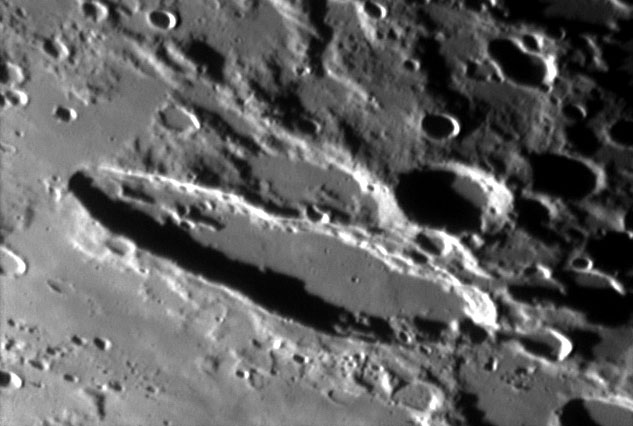July 1, 2009
A Giant Messier

image by Tom Bash
Schiller is bizarrely unique and has long been a topic of speculation and bewilderment. The problem with Schiller is obvious - craters are round, but Schiller definitely isn't. Because of its elongated shape, it was often claimed that Schiller could not be of impact origin and must be volcanic. But, volcanist were wrong again. And they were wrong for a good reason - who could have imaged that an impact event could produce something as non-circular as Schiller? The clue came from high speed-impact cratering experiments at NASA Ames Research Center in California in the 1970s. Vertical impact experiments by Don Gault and colleagues had recreated lunar crater shapes, central peaks and even ejecta deposits. But when the experimenters made oblique impacts they discovered dramatic changes in crater geometry. They were able to show that the crater pair Messier and Messier A were likely produced by a ricocheting impact at an angle of less than 5 degrees. Schiller appears to be another low angle impact of a much larger projectile, at a somewhat higher angle, that made a series of elliptical, overlapping and nearly simultaneous craters. In fact, the linear ridge seen at the northern end of Schiller also appears in the Ames experiments. This good photo also illustrates a later phase of Schiller's development. The lavas that rose up inside the crater created a floor that is not quite level. A previously unknown - at least to me - broad but low diagonal plateau exists on the floor of the broadest part of Schiller. Hmm.
Chuck Wood
This is a repeat of a classic LPOD from Nov 12, 2004. Another proposal is due tomorrow!
Technical Details
Oct 8, 2004. C9.25 + ToUcam web cam
Related Links
Rükl plate 71
Yesterday's LPOD: Flattening Out the Sphere
Tomorrow's LPOD: Surfaces
COMMENTS?
Register, Log in, and join in the comments.



